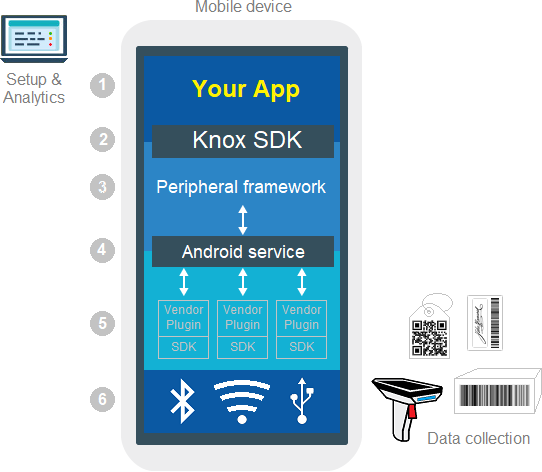Peripherals — How it works
Here is a high-level overview of how your app manages a connected peripheral:

The system components are as follows:
-
Your App — Typically, your app takes instructions from a web-based console, which operational admins use to set up the mobile devices and peripherals remotely. Your app deploys the instructions on the device and connected peripheral.
-
Knox SDK — Your app calls APIs in the Knox SDK to set up both the device and peripheral.
-
Peripheral framework — The beauty with the framework is that your app calls only generic Knox APIs to manage any number of vendor peripherals. Your app doesn’t need to use a vendor-proprietary SDK to manage the peripheral. This simplifies app development and updates as you don’t need to use a whole new set of APIs every time you support a new vendor’s peripheral.
-
Android service — Peripheral vendors use the Android service to handle incoming instructions from your app and return results.
-
Vendor plugin — The onus is on the peripheral vendors provide a plugin app in the form of an Android package (APK) file. This app provides an Android service, accepting requests from your app and using the vendor’s proprietary peripheral SDK to deploy the requests on their peripherals.
-
Peripheral — The peripheral can connect to the mobile device through Bluetooth, Wi-fi, USB, or as an internal component like a built-in camera. The peripheral forwards collected data to the vendor plugin, which in turn forwards the data to your app, which typically forwards the data to a web-based server for centralized processing, monitoring, diagnostics, and reporting.
Currently, through the Knox Developer Dashboard, you can download a plugin APK file for the Koamtac SKXPro SmartSled.
Next — See the Peripherals tutorial for step-by-step instructions.
Is this page helpful?